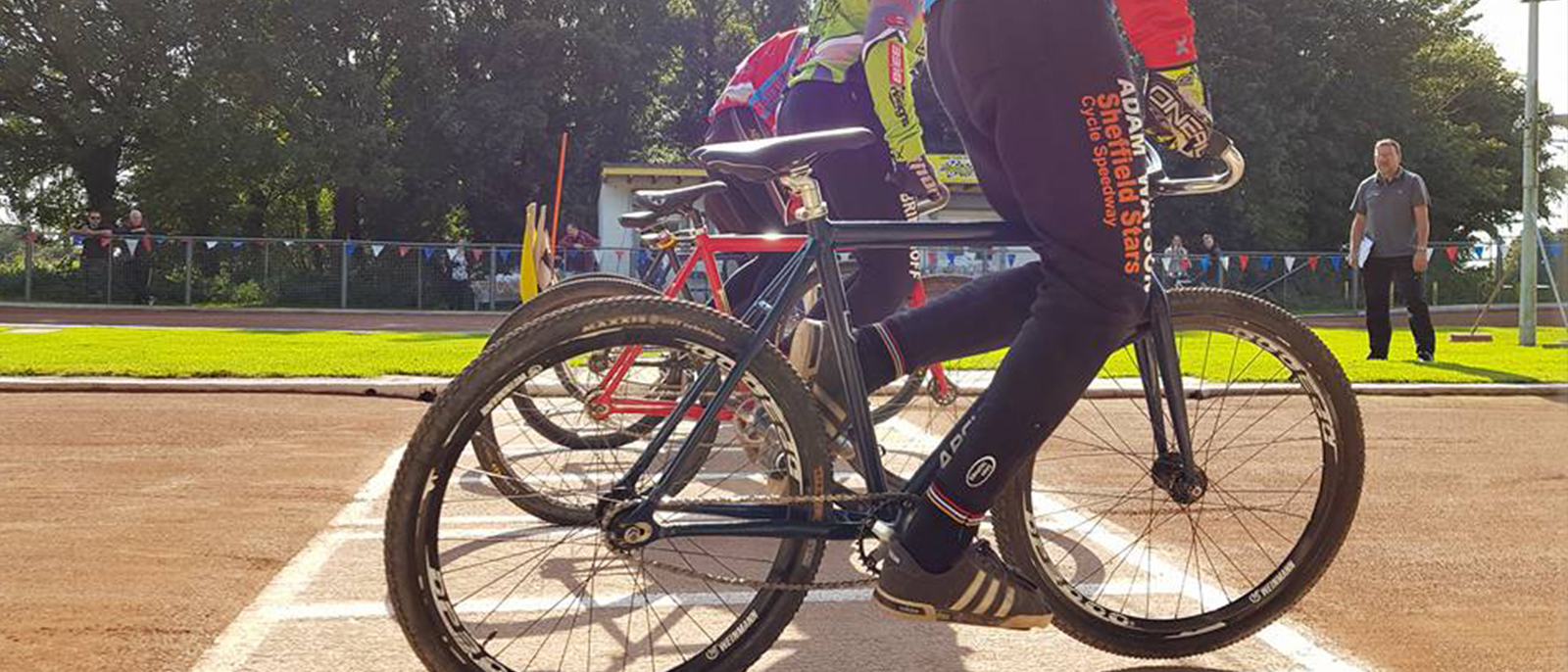What is Cycle Speedway?
Cycle speedway takes place on a banked oval track, usually over 4 laps of a 70 to 90 metre circuit. On a shale surface, four riders compete either in two teams or as individuals in a high speed explosive event that requires fitness, skill and tactical awareness. Each race begins from a standing start with a unique rising gate, typically lasting for 40 to 50 seconds.
Physical contact is allowed and is often necessary to compete at the top level. Riders need to possess a good sprinting ability and also have the strength for contact with other riders and endurance to compete over a full meeting. Skills required include starting, passing, holding your position and tactical awareness.
Tracks
Cycle speedway tracks can be between 64 to 80 metres long, and 4.25 to 7 metres wide. They usually have banked bends of up to 1 in 8 and straights of up to 1 in 12 banking to aid drainage. Surfaces are generally of shale and occasionally of limestone or granite dust. Starting areas are of concrete with a rising gate spanned by 3 white cross tapes. The outer perimeter is more than often surrounded by a safety fence for the protection of riders and spectators.

Hull Cycle Speedway club’s track (The Hessle Raceway) in action.
Competitions
Cycle speedway is essentially a team sport with teams of around 8 racing with 2 riders from each side in each race competing over 18 heats. Racing is organised in a pyramid fashion with an elite league, four regional leagues and then many local leagues. This provides competition for seniors, intermediates and younger riders.
Individual racing is also popular with the British Youth & Junior League (BYJL) providing racing from under 8’s up to under 16’s in two year bandings with a section for older girls. British competitions take place for teams and individuals at under 10 /13/16/19, over 40 and women’s categories. International meetings involve the home nations and also Poland and Australia and more recently the USA and New Zealand. There has been a recent increase in the number of women racing and a women’s league caters for all standards of competitor.
Bikes
Bikes are single speed with low gears typically around 46 inches (33:18). They have a short wheel base with frames having track ends and they have no brakes or potentially dangerous fittings. The bikes usually have straight forks and W shaped handlebars, resin pedals and knobbly tyres. These tyres can fit conventional 26 x 1 3/8” wheels or a wider mountain bike wheel. Hull CSC has a fleet of bikes available to be borrowed for training and competitions, so don’t be put off having a go!

Cycle Speedway Handlebars
Clothing
Helmets must be worn and the rider be fully clothed from the neck down. Long sleeved tops are worn, usually in club colours. Full length track pants can have built in padding at the knees and hips for protection from falls. Full fingered gloves with a good grip are used and flat soled trainers are worn for good pedal contact.

Rider in full kit
Bike Set Up
A rider should be able to stand astride their cycle with a good clearance between the top tube and their groin. The saddle should be set so that the rider can have his feet flat on the floor with a slight bend at the knees. The handlebar height needs to be as low as possible with a short stem, although there must be sufficient clearance between the rider’s knees and the handlebars whist seated. Handlebars are usually set at a level position but can be angled upward depending on rider preference.
Technique
Pedalling and the Racing Line
Riders should pedal with the balls of their feet over the pedal spindle. They need to maintain a smooth continuous action and sprint out of the saddle down the straights. The racing line is the ultimate track position for both speed and to maintain a good position in the race. A rider should pedal along the straight on a wide line. They enter the bend from this wide position as late as possible and aim to get very close to the apex of the bend. From here they aim to return to the wide straight position or they can defend their position with a tighter line.
Cornering
Riders aim to maintain their speed and position whilst cornering. To corner effectively they should enter the bend from a wide position on the straight. They should aim for the apex of the bend and keep their weight back on the seat. As the rider enters the bend they need to keep their right foot on the pedal and extend their left leg outwards as they take the bend. The rider will keep the left pedal high and should lean to the left while using the left leg for balance touching the surface if necessary. The right knee can be tucked into the frame and as the rider exits the bend they look to quickly regain their foot on the left pedal for a fast pick up and then sprint out of the saddle down the straight. On a wet or heavily surfaced track riders should try to pedal further into the bend to maintain their speed and then pick up as soon as possible coming out of the bend.

Starting
A good start is vital to enable the rider to be in a favourable position after the first bend. In team events the sides alternate between grids 1 & 3 and grids 2 & 4 each. Grid 1 is the starting position closest to the inside of the track with grid 4 being closest to the outer edge. Each rider lines up between two parallel lines that are perpendicular to the starting tapes.
The cycle’s cranks should be set in a horizontal position and the rider’s favoured foot is placed on the forward pedal. The other pedal is placed against the achilles tendon of the standing foot with the rider on his toes and used as a brake. The body is kept upright with the rider out of the saddle. They focus on the tapes and are put ‘under starter’s orders’ by the referee for between 2 and 5 seconds before the tapes rise, during which time they must remain still. The rider needs to keep his weight forward to prevent the front wheel lifting but needs to be aware that the rear could slip especially in wet conditions. As the tapes rise they increase the pressure on their pedal foot and lift the other foot off the floor with the intention of regaining the pedal as soon as possible. They should pull on the handlebars and move their body forward to be in a position to sprint to the first bend.

The Start
Stopping & Mounting
It is possible that riders will fall during a race and will need to remount their bike as soon as possible especially if other riders have fallen. The rules state that only 2 steps can be taken with the exception of the final lap where a rider is permitted to run with their bike. The rider should lift their bike and straighten it, in line with the track, on their right hand side. They should then take a couple of strides and lift their right knee over the saddle, landing on the saddle, and looking to make contact with their right foot on the pedal.
Group Riding / Tactics
As there will always be four riders on the track at the same time, each competitor needs to be able to ride in the close proximity of others and to be able to race tactically where necessary. When racing in a group riders should remain relaxed, maintain a good speed, be observant and communicate with their team mate if necessary.
Tactically it is always good practice for a rider to have their opponent on their own shoulder so as they can see where they are and be able to control the race. It is possible from this position to drift an opponent wide and let a team mate through, so a rider needs to be wary when making an outside pass in case this happens. Riders also have to be careful that they do not get trapped on the inside line allowing both opponents to pass around the outside. Physical contact is allowed and the reasonable use of a shoulder or the flick of an elbow can create space for manoeuvre at top speed.

Close quarters
Passing
To pass an opponent a rider can either pass on their inside or outside line. A drop pass begins with a rider taking a wide line into the bend which enables them to exit the bend on a tight line. This allows them to pass the rider in front who had a tighter entry into the bend and hence exited on a wider line. An alternative inside line pass is to move inside an opponent going along the straight or approaching the bend with an element of surprise and, if necessary, with the aid of some shoulder contact.
To pass an opponent on the outside line a rider needs to come from a position off their opponents rear wheel and burst around their outside, The aim is to build up speed going into the bend, pick up early and power around their opponents outside along the straight or coming out of the next bend.
A controlled slide can be used to drop off an opponent’s shoulder entering the bend and gives a more acute angle of attack underneath their opponent. To perform this slide a rider should move their weight to the right side of the bike, lowering the bike closer to the floor and allowing the rear wheel to slide in a controlled movement, steering slightly to the right at the same time. A rider will use a variety of tactics to pass an opponent and by making a move in one direction will hope to drag their opponent off their ideal line and create a pass.

Lining up a pass
Q&A
How Dangerous is it?
This is usually mum’s first question but tell her not to worry because cycle speedway is very safety conscious and serious injuries are few and far between. Riders can expect to pick up occasional knocks and grazes, but generally the sport is no more dangerous than other activities such as football or skateboarding. First aid facilities are compulsory for organised race meetings and trained first aid staff are present at all training sessions.
How Much Will it Cost?
The sport is not at all expensive in comparison to other activities. We do not charge any fees to people wishing to give the sport a go, and it only costs £10 to join the club for the first year and junior riders receive subsidised rates. The club also heavily subsidises team travel throughout the country to enable racing at alternate tracks.
How Do I Start?
We are always on the lookout for new members, so don’t be shy, just introduce yourself to someone and ask if you can have a go. We will be happy for you to have a few practice sessions and provide more information on the sport and what we do. Bikes are available for use from the club until you are ready to spend money on a bike of your own.
Training takes place on Tuesday evenings from 6pm between March & October. Alternatively come along to a match and see the teams in action. Matches take place most Sundays throughout the summer, consult the calendar for specific dates.
For further information please send us a message, either via facebook or our email address at admin@hullcyclespeedway.co.uk

